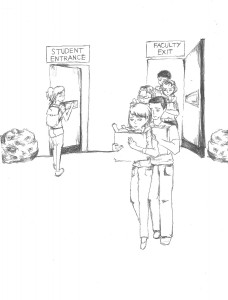
correspondent
The four year run was magical but now it is over. After reaching record enrollment in 2009, the college has now experienced an enrollment drop for the fall semester that will leave the college reevaluating how it will conduct business in the years to come.
After four years of maintaining full capacity now the college estimates a drop for the Fall 2013 semester. The college has benefitted from the 2008 recession. Two-year institutions saw an 8.3 percent increase from 2008-2009 with traditional age first time students, according to National Student Clearinghouse research.
The college website indicates that in Fall 2009 the college broke its record for enrollment with 20,401 students. By Fall 2012, enrollment was still at 20,443. The Board of Trustees approved the 2013-2014 budget with the expectation for a three percent drop in enrollment from Fall 2012 to Fall 2013.
The drop in enrollment has started whispers around the campus. The arrow is no longer pointing up and members of the college are left to wonder what future enrollment might look like. The economy is at least showing signs of recovery, the prognosticators sounding less foreboding in their projections. An improved economy is a great sign for the country, but not necessarily the best sign for a school that has advertised themselves as the cost friendly institution.
The truth is the cheaper cost of a two-year institution does not seem to be the only key to their success over the last four years. According to the National Student Clearinghouse, research on enrollment shows that schools similar to the college have steadily lost two to three percent enrollment in the last three years. The reactionary jump to community colleges — because of the recession — ended in 2010.
The college bucked the trends throughout the nation, during a time when only four-year private non-profit institutions continue to maintain enrollment numbers. Two-year public institutions like the college lost an average of 2.3 percent enrollment from the Spring 2012 to Spring 2013 semesters. Across the board there was two percent drop.
The drop in enrollment for Fall 2013 should not send our school into a fervor or panic of any kind. The options are also not between panic and idly sitting by. The numbers are showing a return to the higher standard (and more expensive) universities. Changes will have to be made, not only by the college, but by all colleges across the country.
Obama’s August 22 speech on the future of government money involved in financial aid is something to keep an eye on. The President tossed around the idea of connecting a college rating to financial aid money, giving a higher federal grant and more affordable loans to students at higher rated institutions. If any parts of his detailed plan come to pass, the federal money allocated to colleges will change vastly over the next decade.
Simply being a cheaper college will not net the same monetary support as being an efficient college that creates a level of learning in line with their tuition costs. Viewing it that way, the most significant effect of the enrollment decrease is its role to approve the budget cuts.
The Board of Trustees remain vocal that the cuts are simply the trimming of the fat and eliminations of redundancies in spending. Hopefully that remains true, because if the college lowers the quality of the education as means to save money in the short term, future changes to the federal dispersal of funds may harm the college in the years to come.
If the college does not want the 2009-2013 years to be the golden age of enrollment at the college, the Board of Trustees may want to tread carefully with budget concerns in the next few years. President Obama’s outline, if passed, may finally reward the college for its high quality low price education that it delivers. That is, if it stands strong even when the up arrow starts to point the other way for a couple years. oint the other way for a couple years.





















